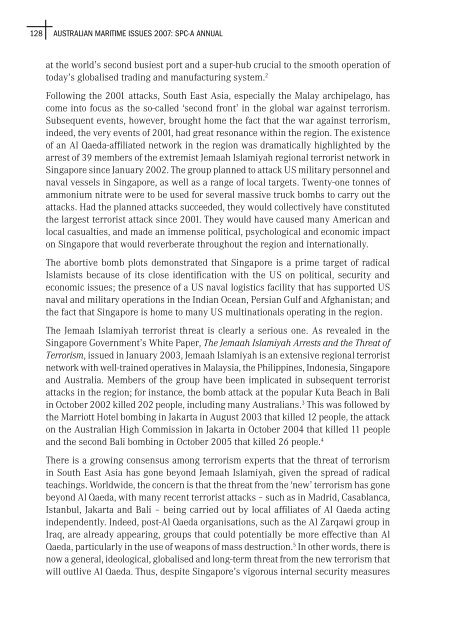Australian Maritime Issues 2007 - Royal Australian Navy
Australian Maritime Issues 2007 - Royal Australian Navy
Australian Maritime Issues 2007 - Royal Australian Navy
Create successful ePaper yourself
Turn your PDF publications into a flip-book with our unique Google optimized e-Paper software.
128 AUSTRALIAN MARITIME ISSUES <strong>2007</strong>: SPC-A ANNUAL<br />
at the world’s second busiest port and a super-hub crucial to the smooth operation of<br />
today’s globalised trading and manufacturing system. 2<br />
Following the 2001 attacks, South East Asia, especially the Malay archipelago, has<br />
come into focus as the so-called ‘second front’ in the global war against terrorism.<br />
Subsequent events, however, brought home the fact that the war against terrorism,<br />
indeed, the very events of 2001, had great resonance within the region. The existence<br />
of an Al Qaeda-affiliated network in the region was dramatically highlighted by the<br />
arrest of 39 members of the extremist Jemaah Islamiyah regional terrorist network in<br />
Singapore since January 2002. The group planned to attack US military personnel and<br />
naval vessels in Singapore, as well as a range of local targets. Twenty-one tonnes of<br />
ammonium nitrate were to be used for several massive truck bombs to carry out the<br />
attacks. Had the planned attacks succeeded, they would collectively have constituted<br />
the largest terrorist attack since 2001. They would have caused many American and<br />
local casualties, and made an immense political, psychological and economic impact<br />
on Singapore that would reverberate throughout the region and internationally.<br />
The abortive bomb plots demonstrated that Singapore is a prime target of radical<br />
Islamists because of its close identification with the US on political, security and<br />
economic issues; the presence of a US naval logistics facility that has supported US<br />
naval and military operations in the Indian Ocean, Persian Gulf and Afghanistan; and<br />
the fact that Singapore is home to many US multinationals operating in the region.<br />
The Jemaah Islamiyah terrorist threat is clearly a serious one. As revealed in the<br />
Singapore Government’s White Paper, The Jemaah Islamiyah Arrests and the Threat of<br />
Terrorism, issued in January 2003, Jemaah Islamiyah is an extensive regional terrorist<br />
network with well-trained operatives in Malaysia, the Philippines, Indonesia, Singapore<br />
and Australia. Members of the group have been implicated in subsequent terrorist<br />
attacks in the region; for instance, the bomb attack at the popular Kuta Beach in Bali<br />
in October 2002 killed 202 people, including many <strong>Australian</strong>s. 3 This was followed by<br />
the Marriott Hotel bombing in Jakarta in August 2003 that killed 12 people, the attack<br />
on the <strong>Australian</strong> High Commission in Jakarta in October 2004 that killed 11 people<br />
and the second Bali bombing in October 2005 that killed 26 people. 4<br />
There is a growing consensus among terrorism experts that the threat of terrorism<br />
in South East Asia has gone beyond Jemaah Islamiyah, given the spread of radical<br />
teachings. Worldwide, the concern is that the threat from the ‘new’ terrorism has gone<br />
beyond Al Qaeda, with many recent terrorist attacks – such as in Madrid, Casablanca,<br />
Istanbul, Jakarta and Bali – being carried out by local affiliates of Al Qaeda acting<br />
independently. Indeed, post-Al Qaeda organisations, such as the Al Zarqawi group in<br />
Iraq, are already appearing, groups that could potentially be more effective than Al<br />
Qaeda, particularly in the use of weapons of mass destruction. 5 In other words, there is<br />
now a general, ideological, globalised and long-term threat from the new terrorism that<br />
will outlive Al Qaeda. Thus, despite Singapore’s vigorous internal security measures
















